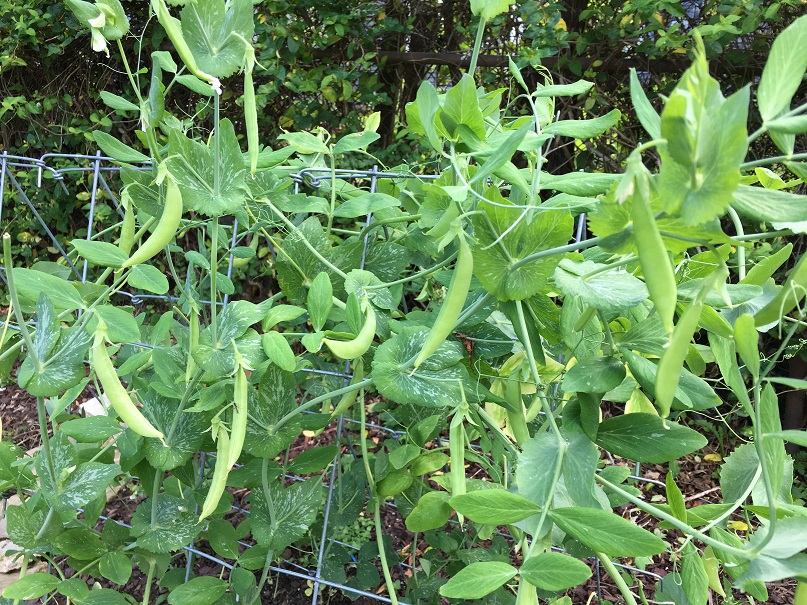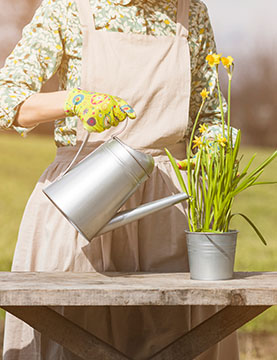Playing Outside in the Spring
In early spring the sunshine and warmer temperatures can tempt you to go outside and plant, plant, plant. But be cautious – we may still have a late frost so those pretty annuals you couldn’t wait to get into the ground may sulk and even bite the dust before you’ve had a chance to enjoy them. Pay a lot of attention to the projected average last frost date. Even if the weather is warm, the ground may still be cold, and a lot of plants don’t like cold feet. Check with your local county extension office to see when it is the best time to start transplanting in your area.
You can cut tea roses back to three inches at outside buds to encourage outer growth. Cut out all inside growth to encourage air flow and minimize black spot fungus. Cut at an angle to prevent water collection. Mulch rose beds to a depth of 3 inches to retard splashing soil fungus on lower leaves. If you haven’t already cut back your Knock Out® roses to an acceptable size and shape, do this now. In some areas where fungus is a problem plan on spraying roses that are not Knock Outs® once a week with fungicide.
If you haven’t already planted your seeds indoors, you should do that immediately.
Cold weather plants such as broccoli, cabbage, brussel sprouts, lettuce, kale, Chinese cabbage, parsley, kohlrabi, fennel, and bok choy can be transplanted directly into the garden now. Sow seeds of sweet peas, onions, onion sets, lettuce, carrots, potato sets, spinach, and shallots.
If you can cover your plants, set out almost any other vegetable plant that you want. There is an exception for northern climates.
Cut and discard last year’s asparagus plants, add compost to the soil or start fertilizing. Asparagus plants are heavy feeders, and the roots migrate to the surface.
After the last frost, plant your annuals. One of the best things you can do for them is to pinch off any blooms as you plant them in your garden. They’re so pretty and that’s why you bought that particular plant but think of it as “tough love.” The plant’s energy will go into developing a strong root system which will help the plant tolerate hot, dry weather and new blooms will last longer.
After the last frost, you may also plant your perennials and ornamental grasses. If need be, you can divide your older ornamental grasses and perennials at this time. If your perennials are taller than four to five inches, cut about one-third before you start.
This is a good time to renew your flower bed mulch, so it is at least three inches deep. This will help the plants retain moisture and be cooler in hot weather.
Plant your Easter lily outside in a sunny spot. Since it can transmit diseases to other lilies, plant it in a different bed from them. All lilies like soil enriched with organic matter, so mix in compost or rotted leaves to a depth of eight inches before planting.
April is a great month to plant evergreen, deciduous and flowering shrubs, and trees.
Never plant them deeper in the soil than they have been grown before.
Never use a string trimmer around shrubs and trees. This can damage the bark especially on young plants. Instead, remove the grass and weeds from a large circular area around the plant and fill it with three to five inches of organic mulch.
In mid to late April, if you haven’t already cleaned out your vegetable and flower beds now is the time to do so. Pull the leaves off and mulch once the ground warms up.
All crops can be planted outside now, but warm weather crops such as melons, corn, squash, tomatoes, egg plant, beans, and peppers prefer waiting until the first of May if not covered.
Wait until crape myrtles leaf out before pruning. Let spring blooming shrubs like star magnolias, rhododendrons and azaleas complete their flowering before thinning their branches. Make sure you thin them, if need be, before they set up next year’s blooms.
Next to fall, this is the best time of the year to sow grass seed. You’ll want to plant grass seed as early as possible to minimize your summer watering.
Plant bare-root roses mid-month so they can develop a good root system before hot weather.
In May cannas, caladiums and elephant ears may be planted since the day and night temperatures are warmer. You could start them indoors in containers around April 1 and then plant them outdoors in May. In the Midwest, treat them as annuals because most will not survive the winters.
You can continue planting annuals and perennials, especially if you intend to use containers. Container growing is a good way to fill in the landscaped beds if you just happen to have a gapping hole from a plant that bit the dust.
Use a slow-release fertilizer when planting perennials, annuals, and bulbs so you won’t have to worry about re-fertilizing until July.
Plant container-grown roses this month and even into June. But the later you plant them, the more likely you will have to watch their water needs more closely. In general, roses perform better when they get enough water, but water early in the day and do not wet the leaves.
Plant all hot weather crops and fertilize all vegetable beds with compost, 10-10-10 or similar facsimile. Harvest asparagus for six weeks, it doesn’t care which six weeks. Cut level with the ground with a knife and attempt to make it to the kitchen before it is consumed.

Using scissors, harvest leaf lettuce early and often. Just give it a haircut and the leaves will soon grow back. These duties are slanted more to the Midwest than the south or the north, but your extension office can help you make any adjustments in the timetable.
National Garden Clubs, Inc. is a 501(c)(3) organization that aims to promote the love of gardening, floral design, and civic and environmental responsibility. There is a local club near you, click here to find one and join. Subscribe to the NGC’s blog by entering your e-mail here. You do not have to be an NGC member to subscribe. NGC welcomes blog article submissions, e-mail the Blog Administrator at blog@gardenclub.org.

 Member Login
Member Login






